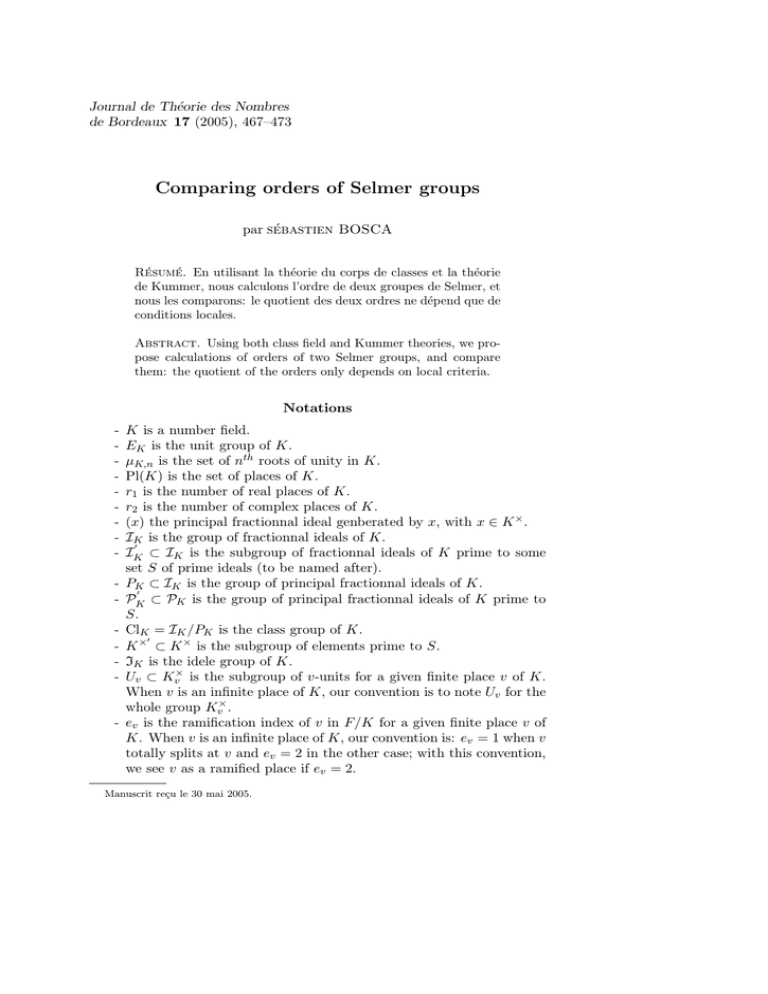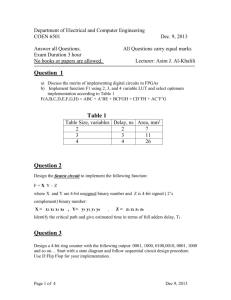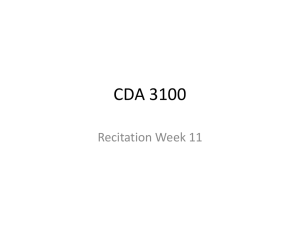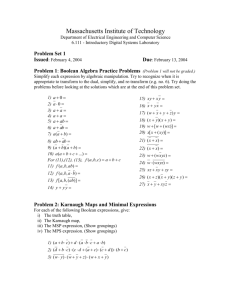Comparing orders of Selmer groups Journal de Th´ eorie des Nombres
advertisement

Journal de Théorie des Nombres
de Bordeaux 17 (2005), 467–473
Comparing orders of Selmer groups
par sébastien BOSCA
Résumé. En utilisant la théorie du corps de classes et la théorie
de Kummer, nous calculons l’ordre de deux groupes de Selmer, et
nous les comparons: le quotient des deux ordres ne dépend que de
conditions locales.
Abstract. Using both class field and Kummer theories, we propose calculations of orders of two Selmer groups, and compare
them: the quotient of the orders only depends on local criteria.
Notations
-
-
K is a number field.
EK is the unit group of K.
µK,n is the set of nth roots of unity in K.
Pl(K) is the set of places of K.
r1 is the number of real places of K.
r2 is the number of complex places of K.
(x) the principal fractionnal ideal genberated by x, with x ∈ K × .
IK is the group of fractionnal ideals of K.
0
IK ⊂ IK is the subgroup of fractionnal ideals of K prime to some
set S of prime ideals (to be named after).
PK ⊂ IK is the group of principal fractionnal ideals of K.
0
PK ⊂ PK is the group of principal fractionnal ideals of K prime to
S.
ClK = IK /PK is the class group of K.
0
K × ⊂ K × is the subgroup of elements prime to S.
IK is the idele group of K.
Uv ⊂ Kv× is the subgroup of v-units for a given finite place v of K.
When v is an infinite place of K, our convention is to note Uv for the
whole group Kv× .
ev is the ramification index of v in F/K for a given finite place v of
K. When v is an infinite place of K, our convention is: ev = 1 when v
totally splits at v and ev = 2 in the other case; with this convention,
we see v as a ramified place if ev = 2.
Manuscrit reçu le 30 mai 2005.
Sébastien Bosca
468
- UK =
Y
v|∞
Kv×
Y
Uv is the subgroup of “units” of IK .
v-∞
- M ⊂ UK is an Y
open subgroup of the unit idele group of K; more
Mv is a product of open subgroups of the multiprecisely, M =
v
plicative groups Kv× , and Mv = Uv if v is a finite place which is not
in S.
0
- PM ⊂ PK is the subgroup of principal ideals generated by an element
x of K × whose image in IK is in Mv for all v in S or dividing the
infinite place of Q.
- N = NF :K is the norm map.
Finally, for a given finite abelian group G and a given integer n, we note
G(n) = {g ∈ G/g n = 1}
and
G(n) = G/Gn .
G(n) and G(n) are respectively the maximal subgroup and quotient of G
with n as an exponant. They have the same order.
Introduction
For a given cyclic extension of number fields F/K with degree n, to
answer a question by Henri Cohen (asked in the particular case F = K(i)),
we propose to calculate the orders of
n
S(F/K) = {x ∈ K × /(x) ∈ IK
, x ∈ N (F × )}/K ×n
and
n
G(F/K) = {I ∈ IK /∃J ∈ IF , N (J) = I}/IK
N (PF ) .
In fact, calculations of the orders of these groups are not very usefull
because we cannot express them only with local criteria (however we express
them with only classical things manipulated in class field theory). But the
point is that the quotient of these two orders only depends on local criteria,
and that was enough to solve the problem of H. Cohen. So, the main result
is the following:
Theorem. If F/K is a cyclic extension of number fields with degree n, one
has:
|µK,n |nr1 +r2
|S(F/K)|
Y
=
.
|G(F/K)|
ev
v∈Pl(K)
Comparing orders of Selmer groups
469
Two ways are given to prove this result: the first one uses class field
theory and interpretations of some groups as Galois groups or Kummer
radicals of some extensions; the second one is faster and only uses the
ambigous classes formula from Chevalley; it was proposed by Georges Gras,
who referred the first version of this article. I thank him for his work. So,
the second way is more acheived, while the first one shows more how to
find the result. Note also that in section 1 (the first way), we suppose that
K contains all nth roots of unity, while in section 2 (the second way), this
hypothesis is useless; that’s a pity, but the question was initially asked for
n = 2 (see [1]), and all number fields contains 1 and −1; moreover, the
calculus made in section 1 can be adapted when K doesn’t contain all nth
roots of unity, replacing K with K[µn ] and things like this, but that seem
complications for nothing since the second way prove the result in all cases.
An interested reader may examine that.
1. Using Class Field theory
1.1. Calculation of the order of S(F/K) as a Galois group.
Here, we see S(F/K) as a ray class group, according to class field theory.
One has a natural map
!
(n)
S(F/K) −→
ClK
φ
x
7→ I/(x) = I n
whose kernel is
Ker φ =
EK ∩ N (F × )
.
n
EK
To study Im φ, let’s note, for each place v of K with w/v in F/K,
Nv = Uv ∩ N (Fw× ), and
Y
M=
Uv ;
v∈Pl(K)
we also note S the set of ramified places in the extension F/K. The Hasse
principle applied in the cyclic extension F/K, leads to
0
0
Im φ = {I ∈ IK
/I n ∈ PM }/PK
,
so that
0
0
|Im φ| = |{I ∈ IK
/I n ∈ PM }/PM ||PK
/PM |−1
0
0
= |(IK
/PM )(n) ||PK
/PM |−1 .
On the other hand, K × ∩M denoting the group of elements of K × whose
image in IK is in M, one has the exact sequence
0
0
0
1 −→ EK /EK ∩ M −→ K × /K × ∩ M −→ PK
/PM −→ 1 ,
Sébastien Bosca
470
so that
0
0
0
|PK
/PM | = |K × /K × ∩ M|/|EK /EK ∩ M|
Y
=
ev /|EK /EK ∩ M| .
v
Using the facts that |S(F/K)| = |Ker φ||Im φ| and that EK ∩ M = EK ∩
n | = nr1 +r2 −1 |µ
N (F × ); |EK /EK
K,n |, one has
|S(F/K)| =
0 /P )(n) |nr1 +r2 −1 |µ
|(IK
K,n |
M
Q
.
v ev
1.2. Calculation of the order of S(F/K) as a radical.
In subsections 1.2 and 1.3 we suppose |µK,n | = n.
S(F/K) is a subgroup of K × /K ×n , so that it is the radical of some
Kummer extension L of K, with exponant n. We should study the local
norm group NL:K (IL ) to calculate the degree of L/K.
Let x ∈ K × /K ×n ; according to the Hasse principle, x ∈ S(F/K) if and
only if:
- n/vP (x) is for each prime P;
- x ∈ Nv for all v ∈ S.
n such
For any prime ideal P, we note ηP the unique element of UP /UP
1/n
that KP [ηP ] is the unique non ramified extension of KP with degree n.
The first condition about the elements of the radical of L/K is equivalent
to the fact that NL:K (IL ) 3 ηP (use the symetry of the local nth Hilbert
symbol to see this: for a local Kummer extension with exponant n Lw /Kv ,
⊥
Rad(Lw /Kv ) ⊂ X ⇐⇒ < Rad(Lw /Kv ), X ⊥ > = 1 ⇐⇒ N (L×
w ) ⊃ X ).
The last condition is equivalent to the fact that NL:K (IL ) contains both ηv
and x0 for each v in S.
Finally, L is then defined by the fact that
NL:K (IL ) ⊃ M∗ InK ,
where
M∗ =
Y
v∈Pl(K)
Nv⊥ =
Y
Nv⊥
v real
Y
v complex
Kv×
Y
Z n
xZ0 ηP
UP .
P prime
Note that M∗ ⊂ UK . So, one has:
|S(F/K)| = |Rad(L/K)| = |Gal(L/K)|
0
= |IK /K × M∗ InK | = |(IK
/PM∗ )(n) | ,
0 /P ∗ is a well known Galois
the last equality coming from IK /K × M∗ = IK
M
∗
group with ray M .
Comparing orders of Selmer groups
471
1.3. Calculation of the order of G(F/K).
One has:
n
|G(F/K)| = |{I ∈ IK /∃J ∈ IF , N (J) = I}/IK
N (PF )|
n
= |N (IF )/IK
N (PF )| ;
note now that IM = IM /UM for M = F and M = K, so that
|G(F/K)| = |N (IF /N (UF )InK N (F × )| .
On the other hand, the Hasse principle leads to
N (UF )N (F × ) = N (IF ) ∩ K × N (UF ) ,
so that
|G(F/K)| = |N (IF )/[N (IF ) ∩ K × N (UF )]InK | .
We now interprete this formula: at first,
IK /K × N (UF )
is, according to class field theory, the Galois group of the maximal abelian
extension of K which is not more ramified than F (note also that N (UF is
equal to M defined in subsection 1.1). Call T this extension. After this,
IK /K × N (UF )InK
is just (Gal(T /K))(n) = Gal(T 0 /K), where T 0 ⊂ T is the maximal subextension with exponant n. So, N (IF )/[N (IF )∩K × N (UF )]InK is the subgroup of
IK /K × N (UF )InK whose elements are norms from IF (since InK ⊂ N (IF )).
But the subgroup of norms from F on the idele side corresponds with the
subgroup obtained by restriction from F on the Galois side, so that
[T 0 : K]
G(F/K) = Gal(T 0 /F ) =
.
n
Now, [T 0 : K] = |Gal(T 0 /K)| = |Gal(T /K)(n) | = |(I0K /PM )(n) |, so that
|G(F/K)| = |(I0K /PM )(n) |/n .
The subsections 1.1 and 1.3 prove the theorem.
2. Using Ambigous classes formula
One has the following 4 short exact sequences, for any cyclic extension
F/K with degree n and σ as a generator of Gal(F/K) (j denotes natural
maps):
n
1 → EK ∩ N (F × )/EK
→ S(F/K) → {c ∈ ClK , j(c) ∈ Clσ−1
F }→1 ,
1 → IFσ−1 j(IK )PF /j(IK )PF → IF /j(IK )PF →
n
N (IF )/IK
N (PF ) = G(K) → 1 ,
Sébastien Bosca
472
1 → j(IK )PF /PF → IFσ−1 j(IK )PF /PF → IFσ−1 j(IK )PF /j(IK )PF → 1 ,
σ−1
σ−1
1 → {c ∈ ClK , j(c) ∈ Clσ−1
→1.
F } → ClK → ClF j(ClK )/ClF
So, one has
n
|S(F/K)| = |EK ∩ N (F × )/EK
||{c ∈ ClK , j(c) ∈ Clσ−1
F }|
n
= |EK ∩ N (F × )/EK
|
|ClK |
σ−1
|ClF j(ClK )/Clσ−1
F |
and
|G(F/K)| =
|IF /j(IK )PF |
σ−1
|IF j(IK )PF /j(IK )PF |
= |IF /j(IK )PF |.
= |ClF /j(ClK )|.
|j(IK )PF /PF |
σ−1
|IF j(IK )PF /PF |
|j(ClK )|
,
|Clσ−1
F j(ClK )|
so that
S(F/K)
=
G(F/K)
=
n|
|EK ∩ N (F × )/EK
|ClK |
|ClF /j(ClK )|.
|EK ∩
σ−1
|ClF
σ−1
j(ClK )/ClF
|
|j(ClK )|
σ−1
|ClF
j(ClK )|
×
n
N (F )/EK |.|ClK |.|Clσ−1
F |
|ClF |
.
Remember now the well known ambigous classes formula from Chevalley
(see [2]): for any cyclic extension F/K with degree n, one has:
Y
|ClK |
ev
v∈Pl(K)
σ−1
;
|ClG
F | = |ClF /ClF | =
n.|EK /EK ∩ N (F × )|
Then, it comes
n |.|Cl |
|EK ∩ N (F × )/EK
S(F/K)
K
=
G(F/K)
|
|ClF /Clσ−1
F
n |.n.|E /E ∩ N (F × )|
|EK ∩ N (F × )/EK
K
K
Y
ev
v∈Pl(K)
n
nr1 +r2 |µK,n |
n.|EK /EK |
Y
Y
=
=
,
ev
ev
v∈Pl(K)
v∈Pl(K)
=
as wished.
Comparing orders of Selmer groups
473
References
[1] Henri Cohen, Francisco Diaz y Diaz, Michel Olivier, Counting Cyclic Quartic Extensions of a Number Field. Journal de Théorie des Nombres de Bordeaux 17 (2005), 475–510.
[2] Georges Gras, Class Field Theory, from theory to practice. Springer Monographs in Mathematics, second edition 2005.
Sébastien Bosca
Université de Bordeaux I
Laboratoire A2X
351, cours de la libération
33405 TALENCE Cedex, France
E-mail : Sebastien.Bosca@math.u-bordeaux1.fr





